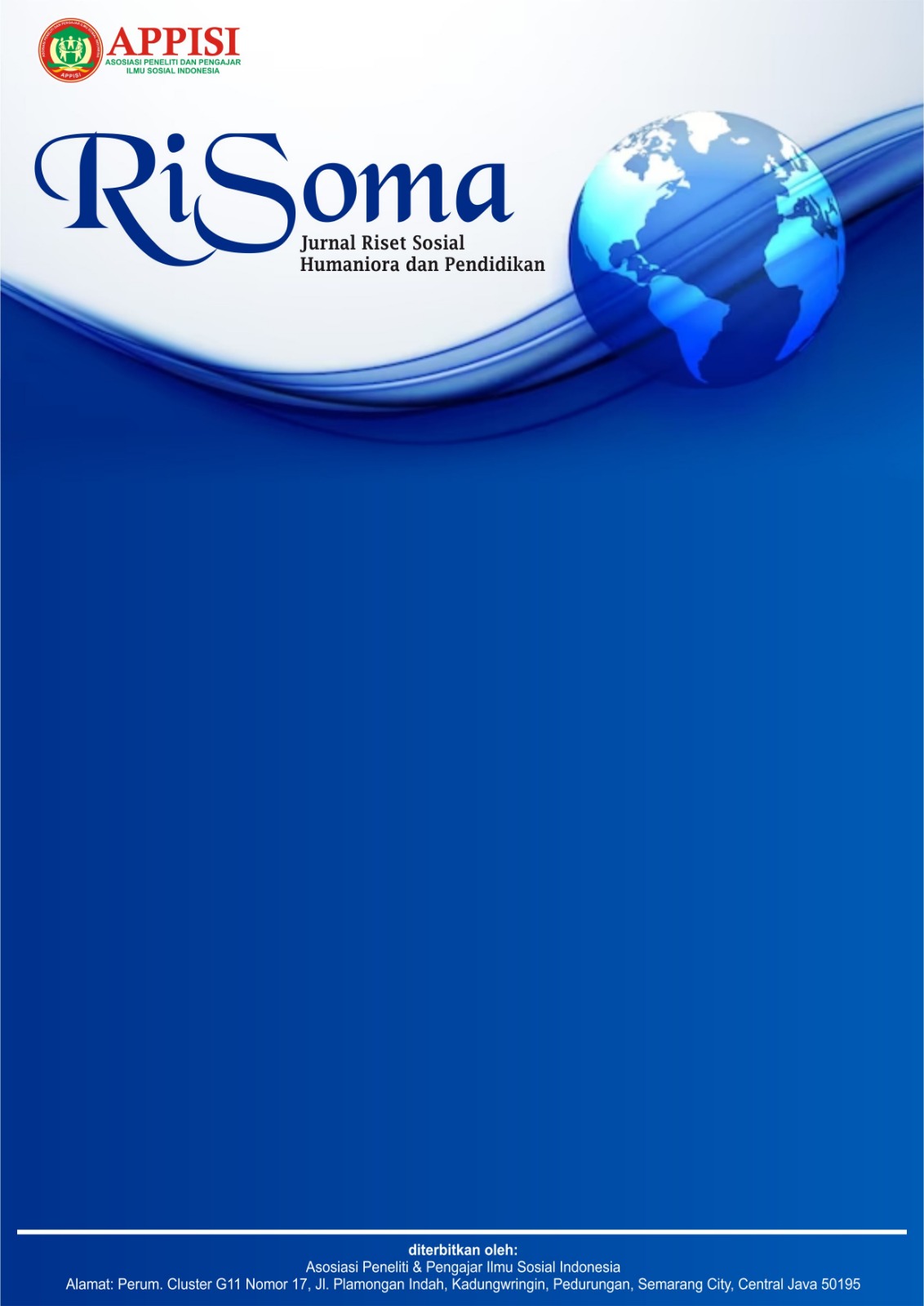Pendidikan Formal Anak Pada Keluarga Miskin di Kelurahan Sialangmunggu Kecamatan Tuah Madani Kota Pekanbaru
DOI:
https://doi.org/10.62383/risoma.v2i5.354Keywords:
Formal Education, Poor Families, Syimbolic ViolenceAbstract
This study aims to analyze the influence of the socio-economic conditions of poor families on the formal education of children in Sialangmunggu Subdistrict, Tuah Madani District, Pekanbaru City. The background of this research is based on the fact that education is an essential need for human survival, and the quality of life of an individual is greatly determined by the level of education they attain. However, access to quality education remains a challenge for families with low economic backgrounds. This research uses a qualitative approach with the theoretical framework of symbolic violence as explained by Pierre Bourdieu, which describes how social structures can create and maintain inequality in access to education. Data was obtained through in-depth interviews with research subjects who are parents from poor families in the study location. The results of the study indicate that the family's economic limitations significantly affect the children's education, as seen from the low level of educational participation, difficulties in meeting educational needs, and the psychological impact on children. Parents from poor families often face difficult choices between meeting daily needs and ensuring their children remain in school. The conclusion of this study indicates that efforts to improve access and quality of education for poor families are essential to break the cycle of poverty and enhance social mobility.
Downloads
References
Abdullah Idi. (2014). Sosiologi pendidikan: Individu, masyarakat dan pendidikan. PT RajaGrafindo Persada.
Ainillah, S. R. (2016). Elite politik dalam kontestasi di desa dengan menggunakan studi peran blater dalam pilkades di desa Banjar, Galis, Bangkalan Madura. Jurnal Politik Muda, 5(3), 282–290. http://www.journal.unair.ac.id/download-fullpapers-jpm018f034c4e2full.pdf
Astuti, L. (2019). Pendidikan anak dalam keluarga dipengaruhi status sosial ekonomi. Jurnal Pendidikan Pembelajaran Pemberdayaan Masyarakat, I(2), 63–75.
Bordieu, P. (2016). Arena produksi kultural: Sebuah kajian sosiologi budaya. KREASI WACANA.
Bordieu, P. (2020). Bahasa dan kekuasaan simbolik (Vol. 1). Diva Press.
Bustamam, N., Yulyanti, S., & Septiana Dewi, K. (2021). Analisis faktor-faktor yang mempengaruhi indikator kesejahteraan masyarakat di Kota Pekanbaru. Jurnal Ekonomi KIAT, 32(1), 85–92. https://doi.org/10.25299/kiat.2021.vol32(1).7677
Delvi. (2015). Manajemen pendidikan anak di kalangan keluarga miskin. Manajer Pendidikan, 9, 115–126.
Fachruddin, F. (2018). Kekerasan simbolik di sekolah. Sukma: Jurnal Pendidikan, 2(2), 311–327. https://doi.org/10.32533/02208.2018
Hidayat, M. S. (2024). Pengaruh latar belakang pendidikan terhadap sikap toleransi di Kelurahan Sialangmunggu. Journal Hub for Humanities and Social Science, 1(1), 38–63. https://ejournal.muhajirinfoundation.org/index.php/jph/article/download/4/6
Ihsan, M., & Solina, E. (2022). Kelompok middle class dalam menghadapi pandemi COVID-19 di Kecamatan Bengkong Kota Batam. Jurnal Sosialisasi, 9, 1–9.
Kartikawati, R. (2017). Model hipotetik program bimbingan dan konseling bidang karir berbasis kelas sosial di sekolah menengah kejuruan negeri rumpun teknologi informasi dan komunikasi Kota Tangerang. Repostory Universitas Negeri Jakarta, 13(3).
Khoiri, H. (2012). Penerimaan orang tua terhadap anak retardasi mental ditinjau dari kelas sosial. Developmental and Clinical Psychology, 1(1), 579.
Kustiawan, W., Taufiqurrohman, A., Syafii, A., Zainina, A., Taminta, N. L., & Miftahul Jannah, N. (2014). Teori pertukaran sosial. Sosiologi.Fis.Unp.Ac.Id, 3(1), 1–9.
Martono, N. (2019). Sekolah inklusi sebagai arena kekerasan simbolik. Sosiohumaniora, 21(2), 150–158. https://doi.org/10.24198/sosiohumaniora.v21i2.18557
Mighfar, S. (2015). Social exchange theory: Telaah konsep George C. Homans tentang teori pertukaran sosial. LISAN AL-HAL: Jurnal Pengembangan Pemikiran Dan Kebudayaan, 9(2), 259–282. https://doi.org/10.35316/lisanalhal.v9i2.98
Napis, A. D. (2017). Peran keluarga dalam pendidikan. Buah Hati, 4(2), 7823–7830.
Ningtiyas, E. (2015). Pierre Bourdieu, language and symbolic power. Poetika, III(2).
Putranto, T. D. (2018). Kelas sosial dan perempuan generasi Z di Surabaya dalam membuat keputusan setelah lulus sekolah menengah atas. Jurnal Komunikasi Profesional, 2(1), 15–28. https://doi.org/10.25139/jkp.v2i1.841
Rahayu, W. P. (2011). Analisis intensitas pendidikan oleh orang tua dalam kegiatan belajar anak, status sosial ekonomi orang tua terhadap motivasi belajar dan prestasi belajar siswa. Jurnal Pendidikan Dan Pembelajaran (JPP), 18(1), 65–71.
Rahmawati, S., Genjik, S. B., & Rustiyarso. (2020). Pengaruh penghasilan orang tua terhadap pendidikan anak. Jurnal Untan, 2(5), 1–11. https://jurnal.untan.ac.id/index.php/jpdpb/article/view/2042
Sutiana, M., Gusti Bujang, & Imran. (2017). Pengaruh pekerjaan, pendidikan, penghasilan, persepsi, dan jumlah anak dalam keluarga terhadap keberlangsungan pendidikan formal. Jurnal Pendidikan Dan Pembelajaran Untan, 6(3), 1–12.
Wardani, W. (2016). Membedah teori sosiologi: Teori pertukaran (exchange theory) George Caspar Homans. Jurnal Studia Insania, 4(1), 19. https://doi.org/10.18592/jsi.v4i1.1111
Zakia, A., Adisti, A. A., & Asmarani, A. (2022). Faktor-faktor yang mempengaruhi kelas sosial: Gaya hidup, daya beli dan tingkat konsumsi (literature review MSDM). Jurnal Ilmu Manajemen Terapan, 3(5), 2–9. https://doi.org/10.31933/jimt.v3i5
Downloads
Published
How to Cite
Issue
Section
License
Copyright (c) 2024 RISOMA : Jurnal Riset Sosial Humaniora dan Pendidikan

This work is licensed under a Creative Commons Attribution-ShareAlike 4.0 International License.





